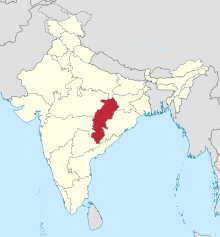Chhattisgarh
Appearance

Chhattisgarh is one of the 29 states of India, located in the centre-east of the country. The state was formed on 1 November 2000 by partitioning 16 Chhattisgarhi-speaking southeastern districts of Madhya Pradesh. The capital city is Raipur. Chhattisgarh borders the states of Madhya Pradesh in the northwest, Maharashtra in the southwest, Telangana in the south (Bhupalpally district), Odisha in the southeast, Jharkhand in the northeast and Uttar Pradesh in the north. Currently the state is comprised of 27 districts.
| This geography-related article is a stub. You can help out with Wikiquote by expanding it! |
Quotes
[edit]- Being composed by princely states in almost two-thirds of their territory, Chhattisgarh was only very partially integrated with the national political arena. A patronage relationship entrenched in the local context remained, and still remains, very strong. The northern region was marked by a strong sense of emulation and competition between Christian and Hindu missionaries. The central plains of Chhattisgarh carried a strong tradition of reformist movements, whereas Bastar in the south was certainly one of the latest to be integrated into the national political fold. The overall picture that remains of the political class of Chhattisgarh is therefore dominated, on the one hand, by local context and kinship, and on the other hand, by the ruling party's ability to co-opt local leaders with not much national-level or even state-level ambition, except a few apparatchik, mainly Brahmins outside of Chhattisgarh, such as the Shukla dynasty and Motilal Vora. To the decline of this sociological class inherited from the traditional leadership of Congress has succeeded the rise of a local political class, also belonging to the upper castes, with a notable number of them having direct affiliation with the RSS, for instance, Dr Ramen Singh and Dilip Singh Yudev, and another important branch represented by the Baniya class, namely, Aggrawal. Nevertheless, it is worth noticing that Arjun Singh, who is from a Baghel Rajput family from the nearby region of Rewa, has been instrumental in undermining the Shukla–Vora stronghold.
- Christophe Jaffrelot; Sanjay Kumar (4 May 2012). Rise of the Plebeians?: The Changing Face of the Indian Legislative Assemblies. Routledge. p. 328. ISBN 978-1-136-51662-7.

